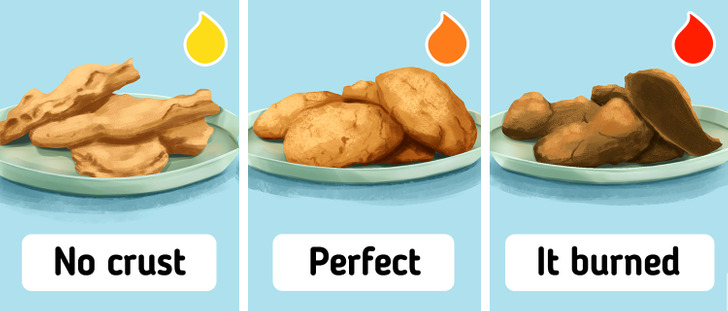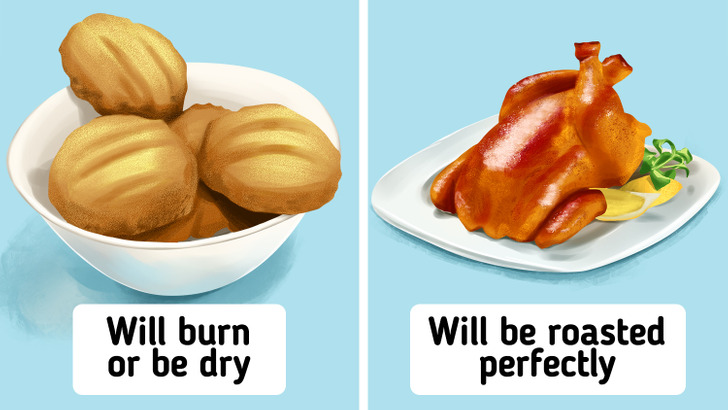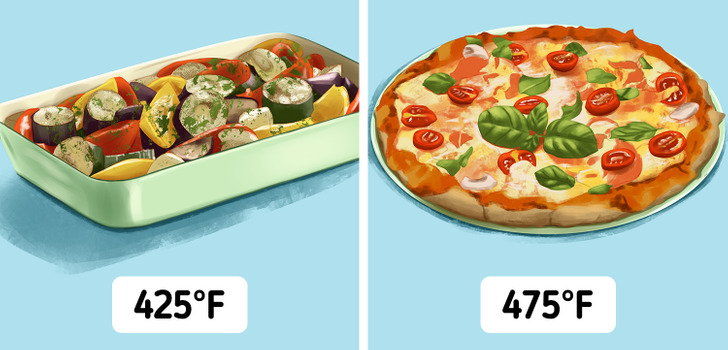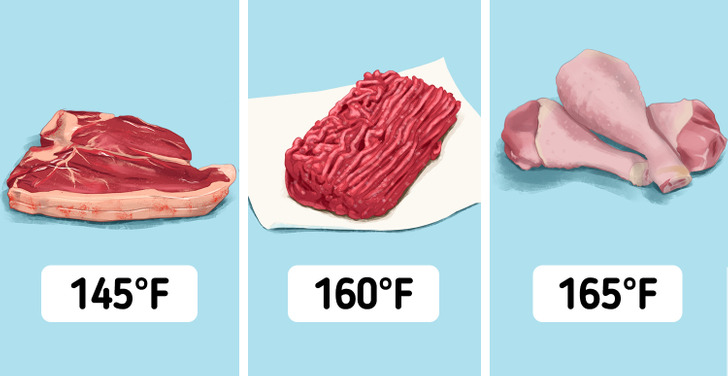Why Most Food Should be Cooked at 350°F
Temperature plays an important role in cooking, although it’s not always that obvious. For example, if you are baking a cake in the oven and you want to do it faster, you may try to simply increase the temperature. But you’ll get a dry and hard cake as a result. Or another example: you made a homemade pizza, it turned out juicy and tasty, but without the signature crispy crust, although you baked it for almost half an hour at 350°F. So what is the problem?
5-Minute Crafts would like to tell you about the role of different temperatures in cooking.
Temperatures below 320°F
There are dishes for which even medium temperatures are fatal. For example, meringues made from egg whites and sugar have a very delicate texture.
In the process of baking in the oven, meringues should become a little firmer inside (while retaining tenderness and some elasticity), but at the same time have a hard and brittle crust. Therefore, they require baking for a long time. First the oven should be preheated to 250°F, and then the temperature should be reduced to 195°F.
Temperatures 325-350°F

At temperatures above 300°F, the caramelization process begins and the Maillard reaction occurs. During the first process, sugar turns brown, getting its characteristic crust and caramel flavor. And during the second process, a chemical reaction occurs between sugars and amino acids, which results in the characteristic smell, color, and taste of cooked food. Thanks to these processes we find a dish delicious.
If temperatures are lower than that, these chemical reactions won’t occur and the result of the cooking will most likely be disappointing. Baking cookies can be a great example:
- At the recommended temperature of 350°F, excess moisture is removed from the dough, a golden brown crust forms on the surface, and the characteristic flavor appears.
- If the temperature is too low, moisture will be removed from the dough, but the crust won’t appear.
- If, on the contrary, the temperature is too high, the cookies will burn.
Therefore, if the cooking process requires some time — for example, if you need to slowly fry or stew food, it’s better to adhere to a temperature regime of between 340°F-350°F. Cakes, muffins, biscuits, or cake layers are also often baked at 350°F because they contain a significant amount of sugar.
Temperatures 375-400°F

At these temperatures, you can quickly bake or fry food to get a crispy crust. These temperatures are ideal for roasting chicken in the oven if you want to get a golden crust.
But the higher the temperature is, the more likely the dish will burn, so it’s best to keep an eye on it while it’s cooking. For the same reason, you should not raise the temperature, hoping that the dish will cook faster this way.
Temperatures higher than 425°F

If you want to bake vegetables in the oven until they are golden brown, select a temperature between 425°F and 450°F. It’s suitable for dishes that need to be cooked for a short period of time. For example, these temperatures are ideal not only for cooking vegetables in the oven (giving them a characteristic crust and leaving a juicy pulp), but also for baking puff pastry (so that the dough rises well and its thin sheets are baked properly).
High temperatures, at which the oven is preheated to 475°F and above, are great for baking pizza or bread: the dough will rise and cook before the gluten has a chance to set, but you have to monitor the readiness of the dish, otherwise you risk getting a burnt pizza.
However, these temperatures should be assigned by the original recipe: in wood-fired ovens, where pizza is usually baked, temperatures can reach over 900°F. Therefore, at home, you can use the highest temperature your oven is capable of. This way, you’ll get a pizza with a really crispy crust, while the dough and toppings will be baked properly, and the cheese will be melted and evenly distributed.
Tip: Before baking pizza, you need to preheat the oven to the maximum temperature for 30 minutes.
What is important to know about temperatures when cooking meat, fish, or eggs

If you cook eggs, fish, or meat, it’s better to ensure that the temperature inside the finished dish is high enough to kill all bacteria:
- 145-165°F are good for fresh meat steaks, chops, fish, and shellfish
- 160°F is good for eggs, and any minced or ground meats (including rabbit)
- 165°F is good for poultry
Besides, in some cases, it’s recommended to leave the meat for 3 minutes in the same dish where it was cooked, but remove it from the heat source, for example, by placing it on a work surface. This way the dish will be able to rest, which will positively affect its taste and juiciness. This applies primarily to steaks and beef chops, veal and lamb, and fresh pork dishes.
Important: Any product needs a little time to get heated to a particular temperature. For example, it takes an egg a few minutes in hot water to cook until the yolk and the white are firm. Therefore, it’s worth using a meat thermometer with a probe to measure the temperature closer to the center of the piece of meat or fish that you are cooking.